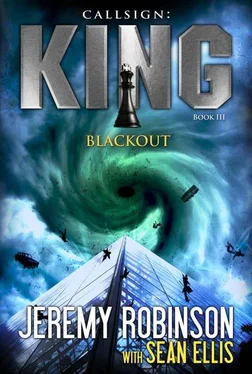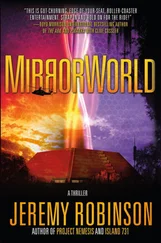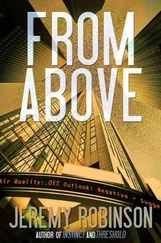Jeremy Robinson - Blackout
Здесь есть возможность читать онлайн «Jeremy Robinson - Blackout» весь текст электронной книги совершенно бесплатно (целиком полную версию без сокращений). В некоторых случаях можно слушать аудио, скачать через торрент в формате fb2 и присутствует краткое содержание. Жанр: Триллер, на английском языке. Описание произведения, (предисловие) а так же отзывы посетителей доступны на портале библиотеки ЛибКат.
- Название:Blackout
- Автор:
- Жанр:
- Год:неизвестен
- ISBN:нет данных
- Рейтинг книги:4 / 5. Голосов: 1
-
Избранное:Добавить в избранное
- Отзывы:
-
Ваша оценка:
- 80
- 1
- 2
- 3
- 4
- 5
Blackout: краткое содержание, описание и аннотация
Предлагаем к чтению аннотацию, описание, краткое содержание или предисловие (зависит от того, что написал сам автор книги «Blackout»). Если вы не нашли необходимую информацию о книге — напишите в комментариях, мы постараемся отыскать её.
Blackout — читать онлайн бесплатно полную книгу (весь текст) целиком
Ниже представлен текст книги, разбитый по страницам. Система сохранения места последней прочитанной страницы, позволяет с удобством читать онлайн бесплатно книгу «Blackout», без необходимости каждый раз заново искать на чём Вы остановились. Поставьте закладку, и сможете в любой момент перейти на страницу, на которой закончили чтение.
Интервал:
Закладка:
Three thousand people died… Grandma died… and I get to visit Paris.
She rubbed her eyes, banishing the tears. “I thought there was supposed to be a carousel.”
She had to fight to get the words past the lump of emotion in her throat, but if Sara noticed, she gave no indication. Instead, King’s girlfriend consulted a tourist pamphlet. “Place du Carrousel,” she said after a moment, “gets its name from a type of military review that took place here back in the seventeenth century. Troops on horses, paraded in front of King Louis XIV.”
“So, no carousel?”
Sara shook her head, her short spiky hair barely moving with the gesture. “Sorry, kiddo. Just a big park. Want to grab a taxi and head over to the Eiffel Tower?”
That was the last thing Fiona wanted to do. Place du Carrousel, a large circular area between the Louvre Museum and the expansive park known as Jardin des Tuileries, had been in easy walking distance from their hotel and had seemed like the perfect place to stretch their legs after the exhausting flight. A proper visit to the Louvre would require at least a full day, maybe more, but there was plenty to see in the park-monuments and performers. Right now though, Fiona just wanted to crawl into bed and hide from Paris. She turned away from the skyline and let her eyes drift along the current of people moving through the park, some of them on their way to the magnificent Louvre Museum, most of them obviously tourists, just like her.
I’ll bet their vacation didn’t cost three thousand lives, Fiona thought bitterly.
“No,” she said finally. “We should save that for when dad…”
Fiona’s voice trailed off as her gaze settled on a tall figure moving purposely through the courtyard. Her eyebrows came together in a crease as she watched the man stride past, not twenty-five yards from where they stood. He bypassed the glittering glass pyramid that decorated the expansive courtyard in front of the main entrance, and continued up the Place du Carrousel toward the busy intersection with the Rue de Rivoli. “What’s he doing here?”
Sara looked up from her pamphlet. “What? What’s who doing here?”
Curiosity overshadowing her grief, Fiona grabbed Sara’s hand. “Come on. Let’s follow him.”
6
Julia Preston watched museum visitors come and go from La Chappelle gallery. Like window shoppers perusing the wares in a high-end retail store, they did not linger, and she found their apparent lack of interest discouraging. It was, she supposed, to be expected. People were so utterly predictable. Tourists-and that’s what most of them were-did not explore places like the Musee du Louvre with an open mind, eager to make new discoveries, but instead brought their expectations with them, checking items off a list.
See the Mona Lisa. Check. What’s next?
She wondered how many of them would, fifteen minutes hence, even remember what they had seen in this room. Few, if any, would grasp its significance, or recognize that they had glimpsed a part of human history that predated Leonardo Da Vinci by nearly a thousand years.
Unlike the pyramids of Egypt or the Acropolis of Athens, the Buddhas of Bamiyan were monuments that relatively few of the planet’s inhabitants had been privileged to gaze upon. In the early sixth century, the Hazara occupants of the Bamiyan Valley had carved two monumental statues from the native sandstone, modeling details upon the rock foundation using a traditional composite of mud and straw, covered with stucco. The statues had been noteworthy for being the tallest images of Buddha in a standing pose-the larger of the two measured one hundred and eighty feet-but because of their remote location, eight thousand feet above sea level in Afghanistan, they had not achieved the same level of notoriety as other monumental constructs. Time and weather had worn at the statues, scouring away much of the original detail, but it had been a deliberate act of vandalism that ultimately brought down the Bamiyan Buddhas. In March of 2001, just a few short months before the events of 9/11 plunged the turmoil-prone region back into a state of war, the oppressive Taliban regime, reversed an earlier position that the Buddhas were of historical value and deserving of protection. They had declared the statues to be idols, forbidden by Islam-even though there was not a single Buddhist in the country who might have venerated them-and ordered their destruction.
Following the subsequent overthrow of the Taliban, an effort had been made to restore the Buddhas, but progress had been hampered by the ongoing war, funding problems and international politics. A further complication had arisen in late 2011, when the United States had, in protest of UNESCO’s decision to recognize Palestine, withdrawn financial support from the United Nations’ cultural agency, which had designated the Bamiyan Valley a World Heritage Site. The traveling museum exhibition, represented a last ditch effort to raise awareness of the flagging restoration effort.
On a technical level, the exhibition was spectacular. It featured state of the art full-sized holographic reproductions of the Buddhas as they would have appeared at the time of their completion. A museum visitor could stand at the foot of the statues and gaze up at the eighteen story high likeness of the Buddha, never realizing that it was an illusion created by lasers and mirrors. Of even greater significance, at least to Julia’s way of thinking, were the countless fragments of the actual statues that had been painstakingly collected from the floor of the Bamiyan Valley, and which now rested in dozens of glass display cases. Most of these pieces were nothing more than chunks of sandstone, scarred and scorched by the barrage of artillery rounds and dynamite charges that had reduced the Buddhas to rubble, but on a few it was still possible to see where ancient craftsmen of the Gandhara Empire had carved the folds of the Buddha’s robes.
Yet, for all the technological sophistication and cultural relevance, the exhibition was plagued by the same general apathy that had stymied the restoration effort. Julia had watched museum visitors come and go for several days now; their indifference was almost palpable. But every once in a while, someone would stop and she could see the glimmer of appreciation in their eyes as they read the placards, gazed in awe at the dioramas, and then, almost reverently, placed their hands on the glass display case containing the fragments, as if wishing they could actually touch this part of history.
Her gaze alighted on one figure, a man, who seemed to be taking more than just a passing interest in the exhibit. As she watched, he moved from one display to the next, carefully perusing the descriptive passages before studying the contents. Edging closer, Julia noticed first that the man’s silvery-blue eyes were turned to the paragraphs written in English. Then she noticed the handsome face around those eyes.
The eyes shifted ever so slightly, catching her reflection in the glass display case, and then the dark haired man straightened and turned toward her.
Mildly embarrassed at having been caught staring, she hastily tried to deflect his attention. “Tragic, isn’t it?”
The corners of the man’s mouth tugged up a little into a rueful smile. “That’s one word for it,” he replied, seeming to agree.
She nodded. “That these marvelous statues could endure the ravages of time for so long, only to be destroyed in a cowardly display of ignorance.”
“Cowardly,” the man echoed, thoughtfully. “Perhaps. But I don’t think ignorance was a factor. The men who destroyed the Buddhas understood all too well the importance of symbols. This was no mere act of vandalism.”
“That’s a very astute observation.” Julia stuck out a hand. “I’m Julia Preston, curator-at-large for the Global Heritage Commission.”
Читать дальшеИнтервал:
Закладка:
Похожие книги на «Blackout»
Представляем Вашему вниманию похожие книги на «Blackout» списком для выбора. Мы отобрали схожую по названию и смыслу литературу в надежде предоставить читателям больше вариантов отыскать новые, интересные, ещё непрочитанные произведения.
Обсуждение, отзывы о книге «Blackout» и просто собственные мнения читателей. Оставьте ваши комментарии, напишите, что Вы думаете о произведении, его смысле или главных героях. Укажите что конкретно понравилось, а что нет, и почему Вы так считаете.












